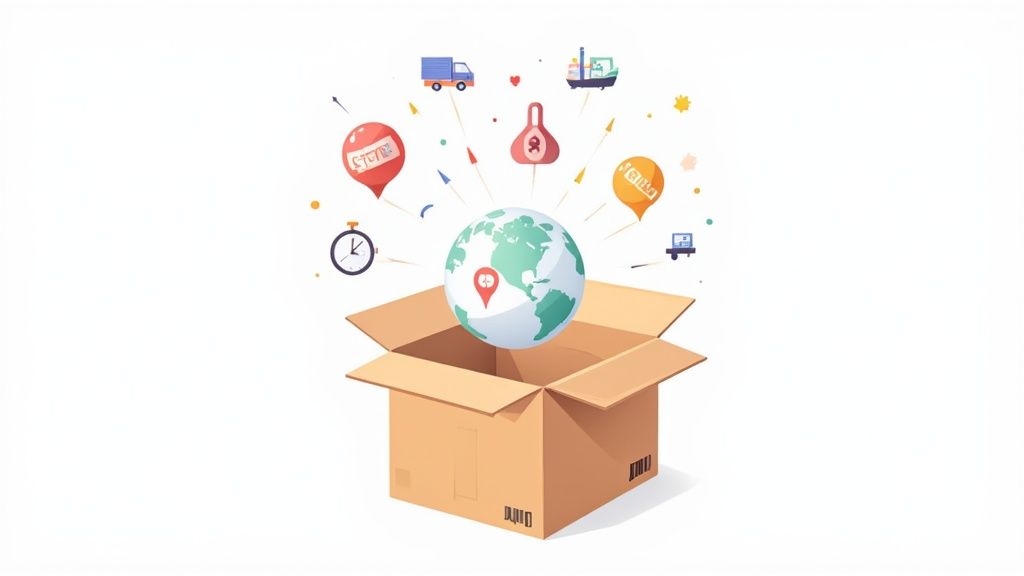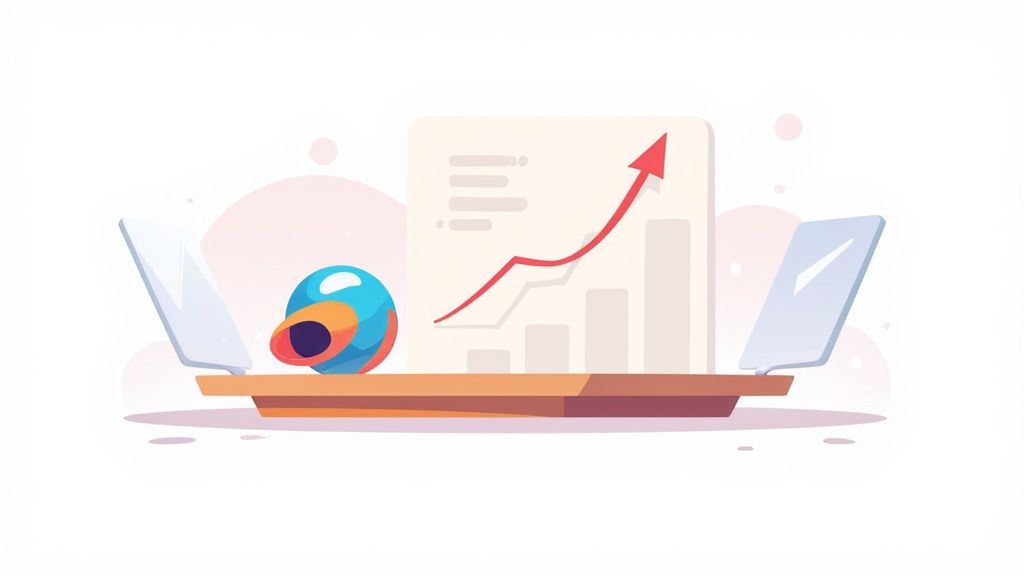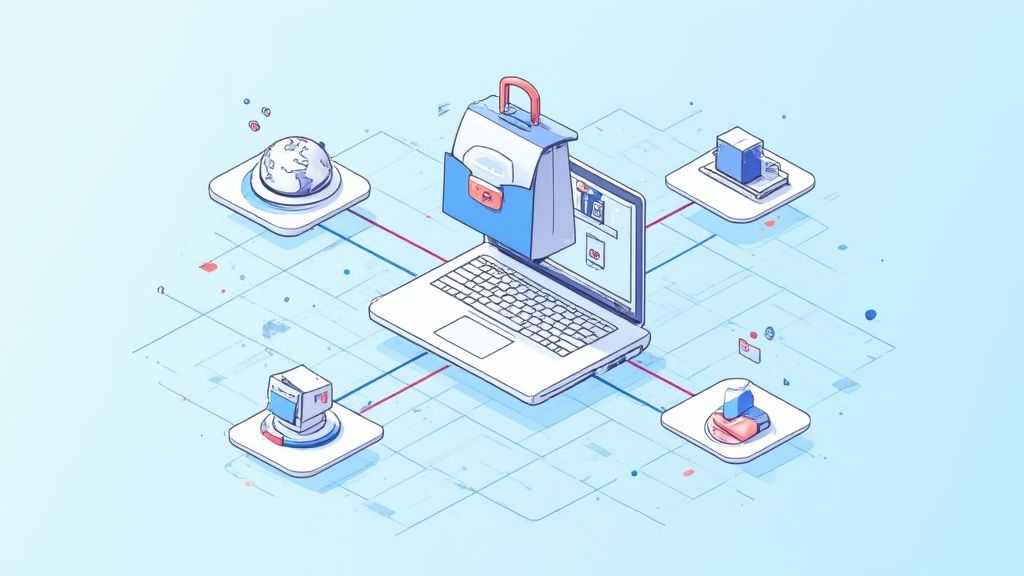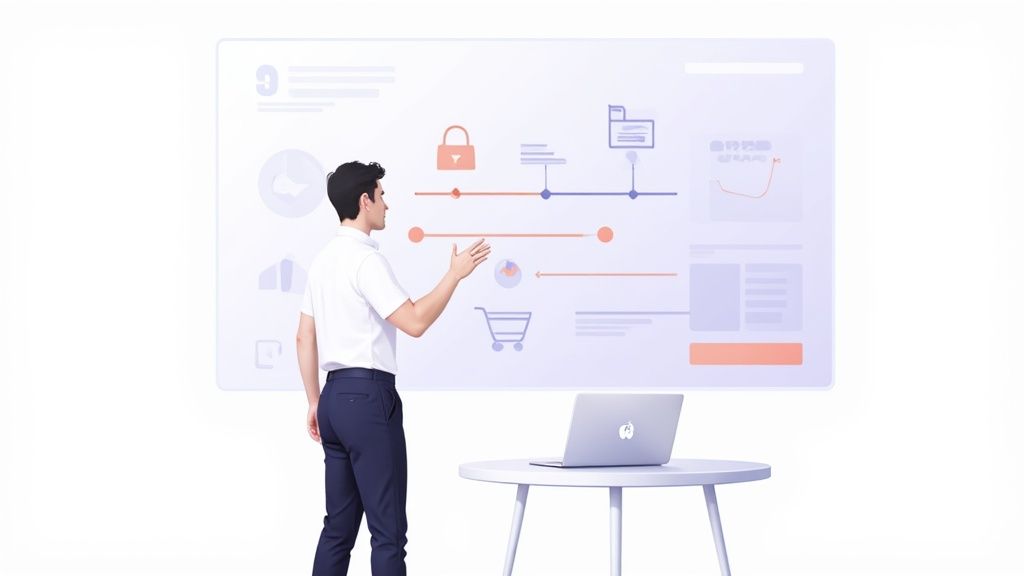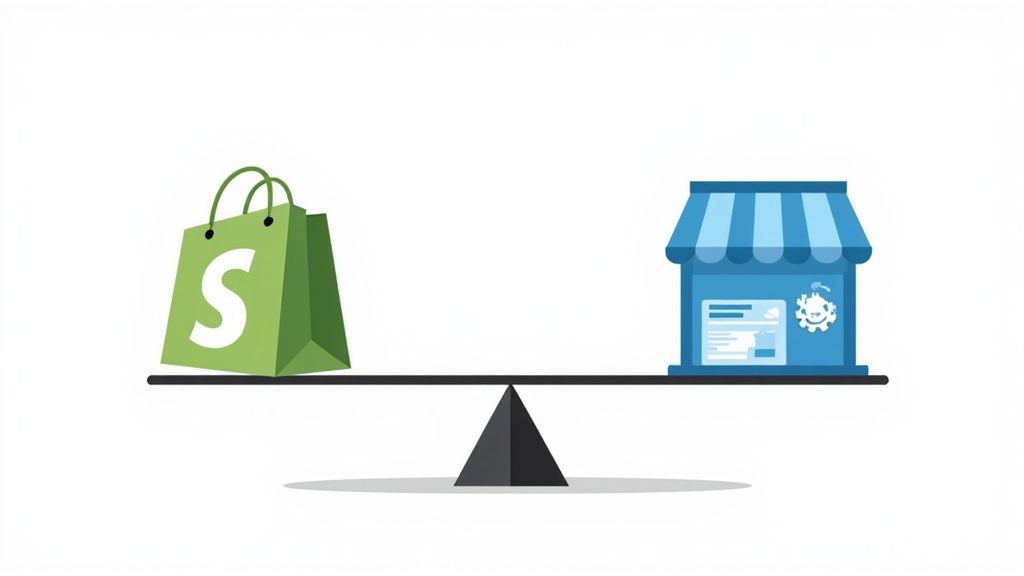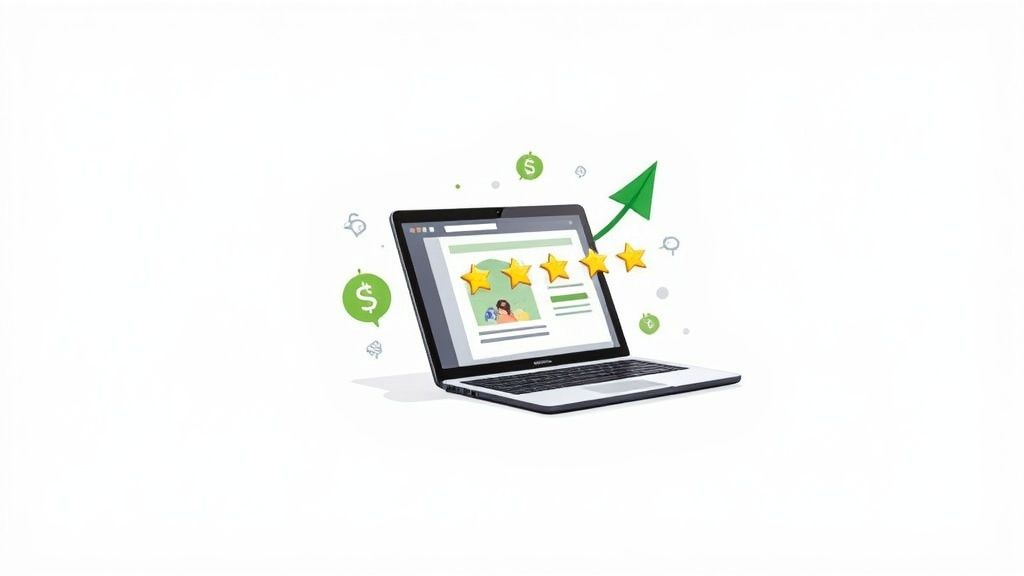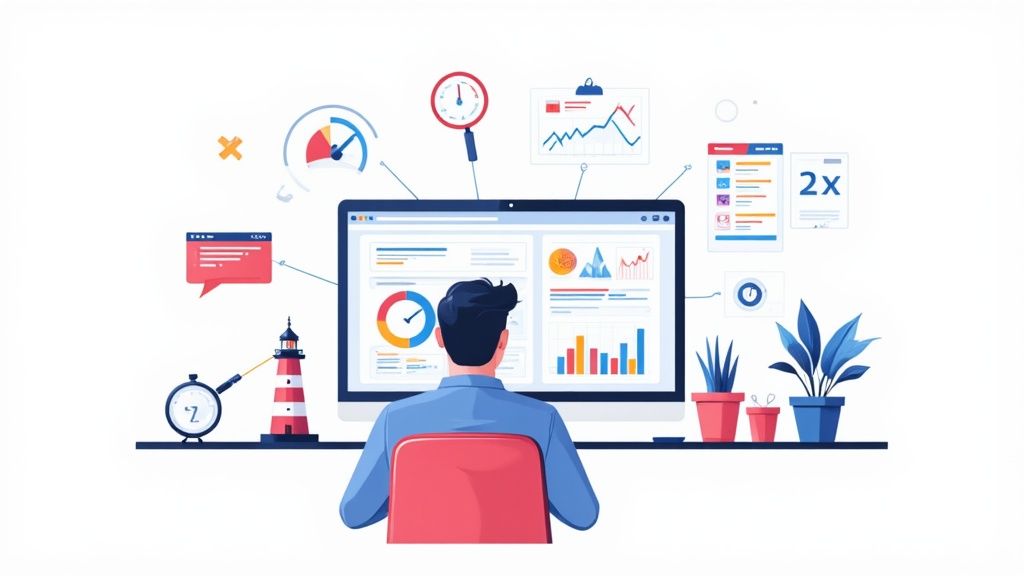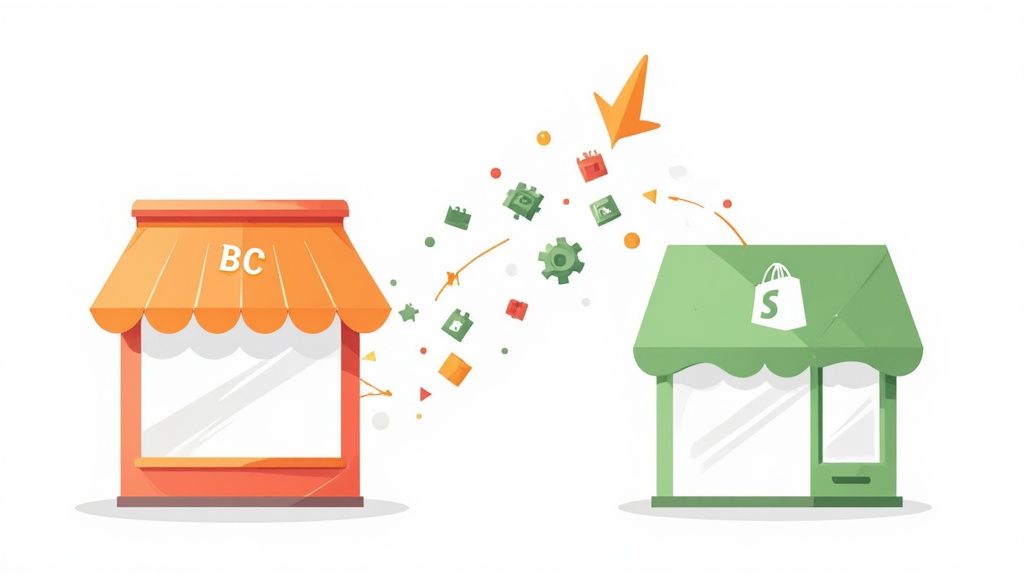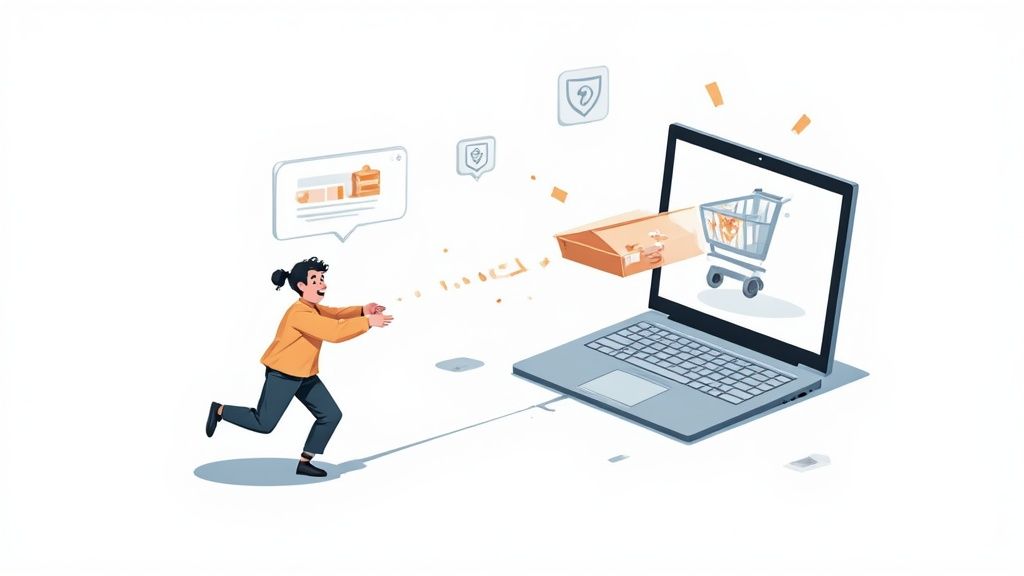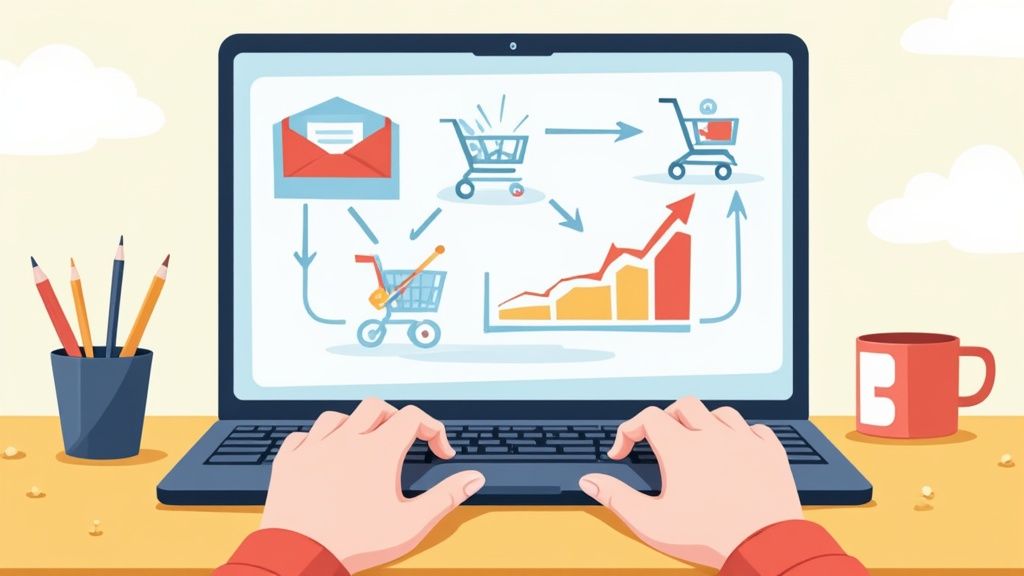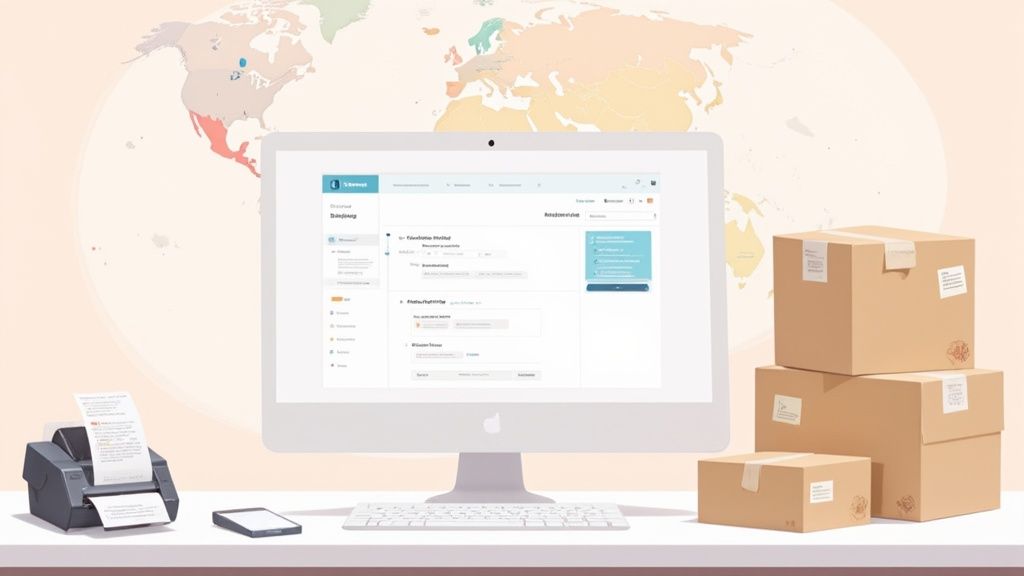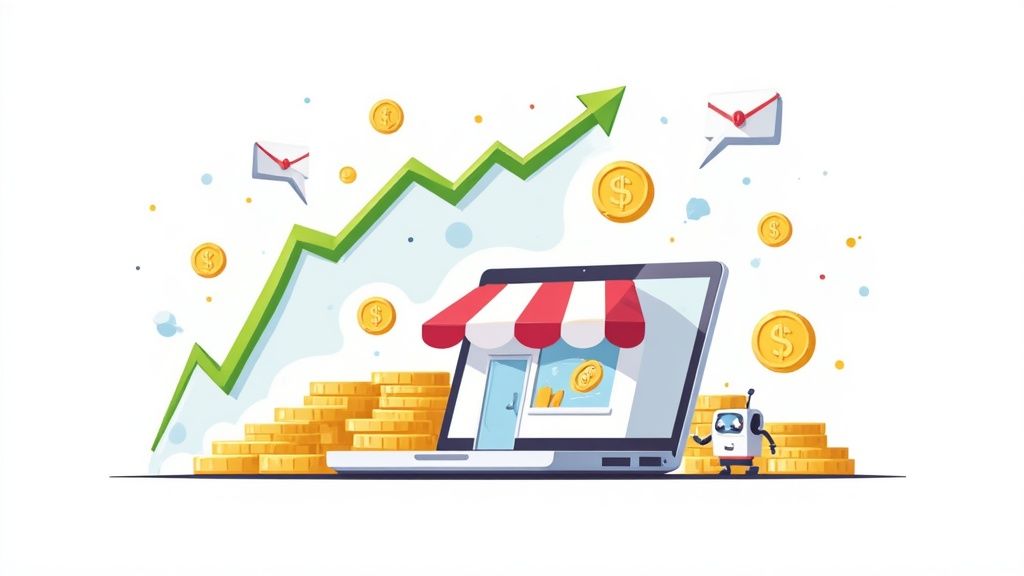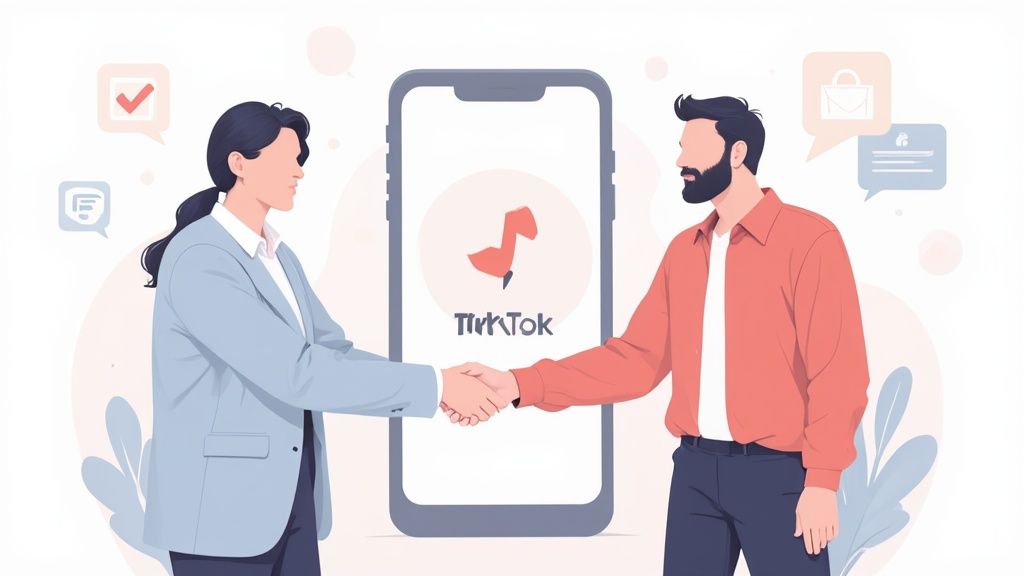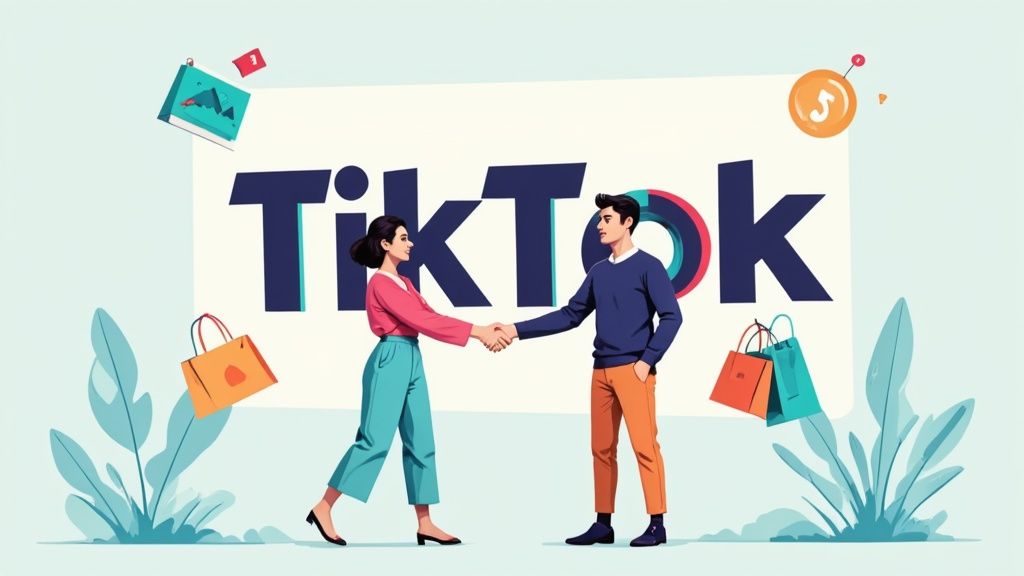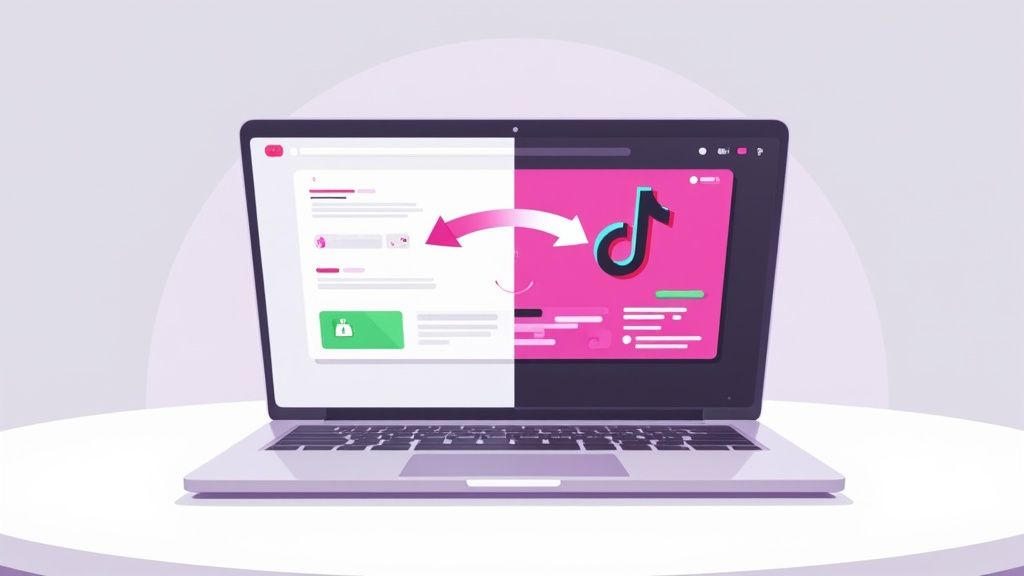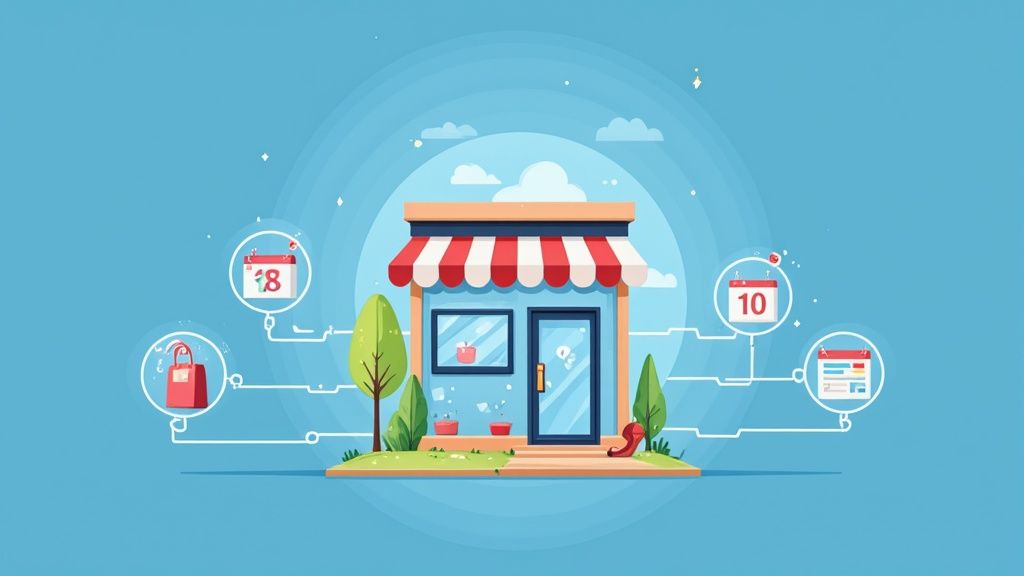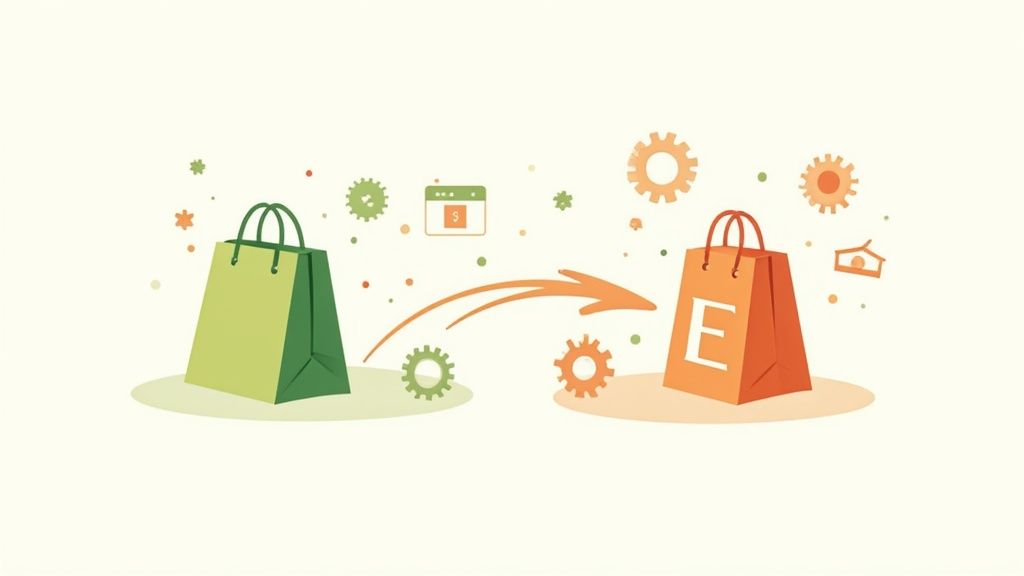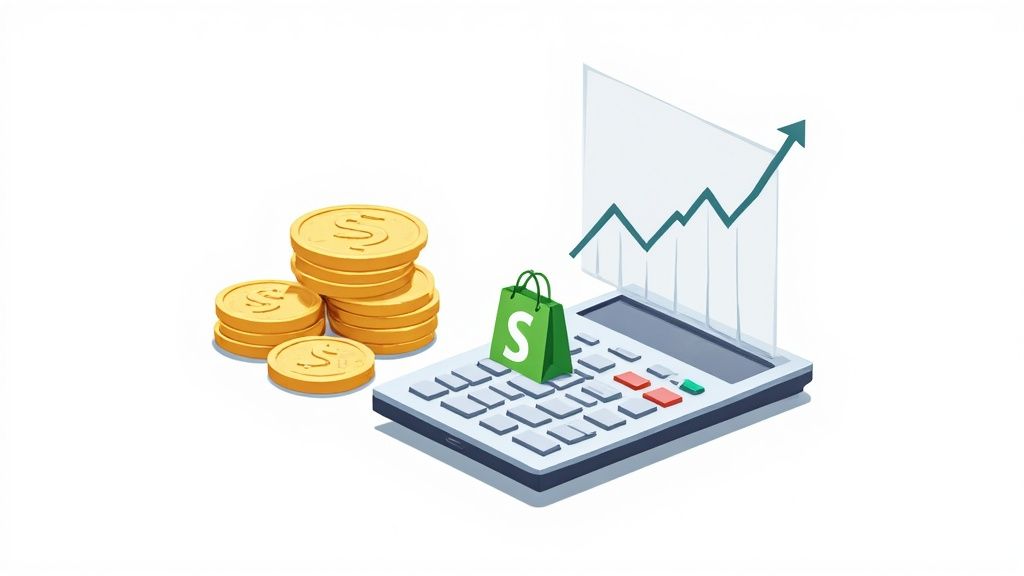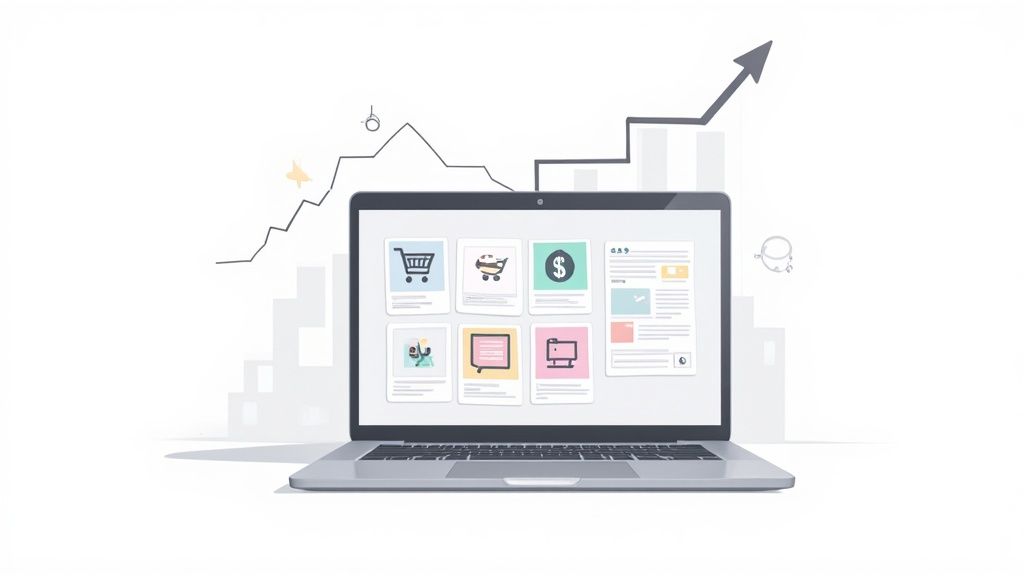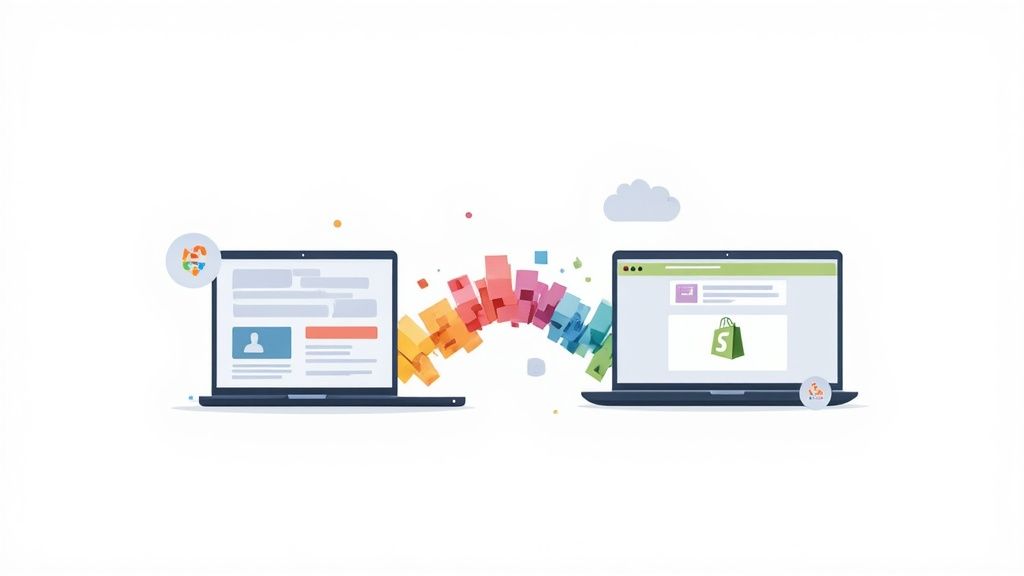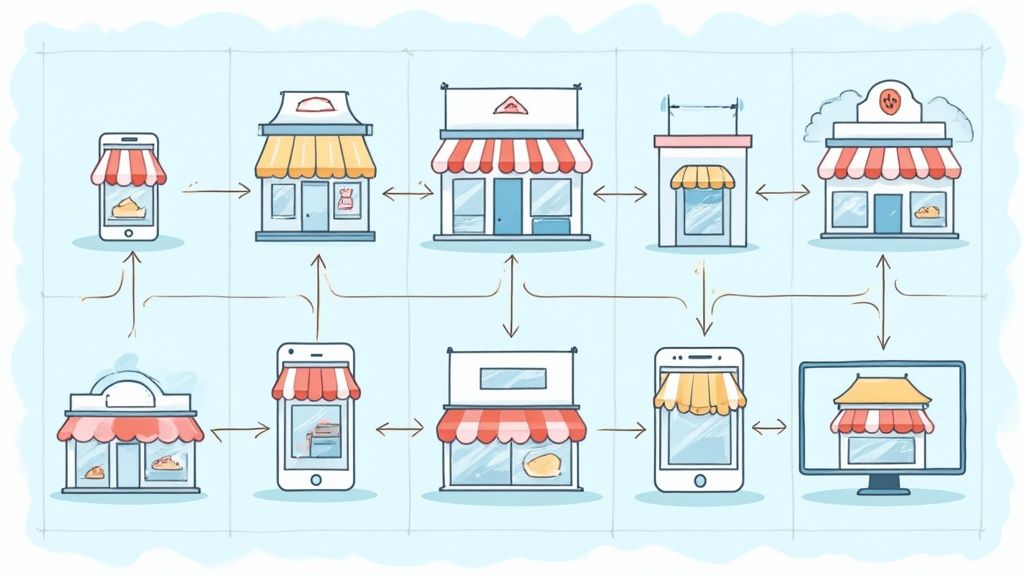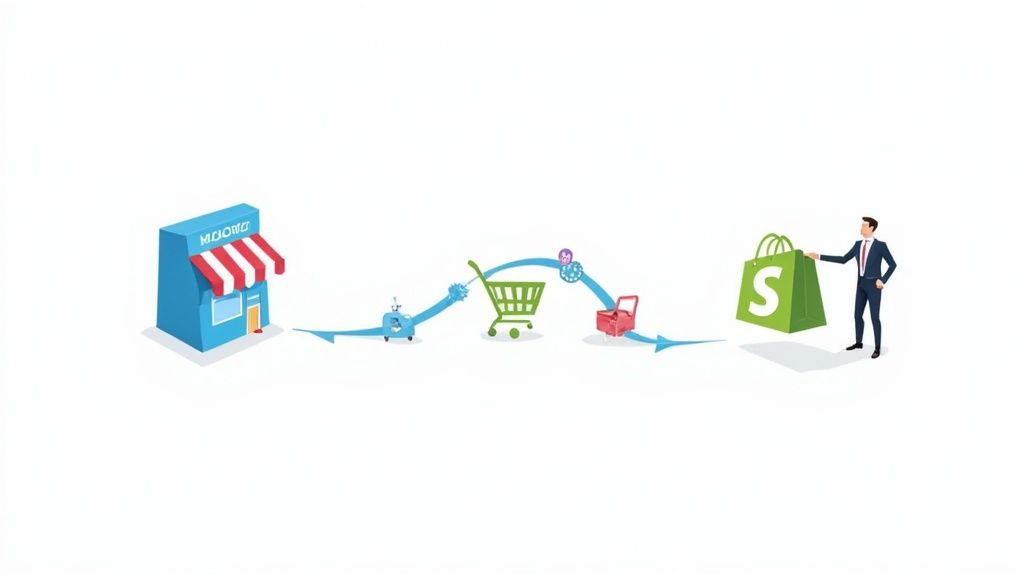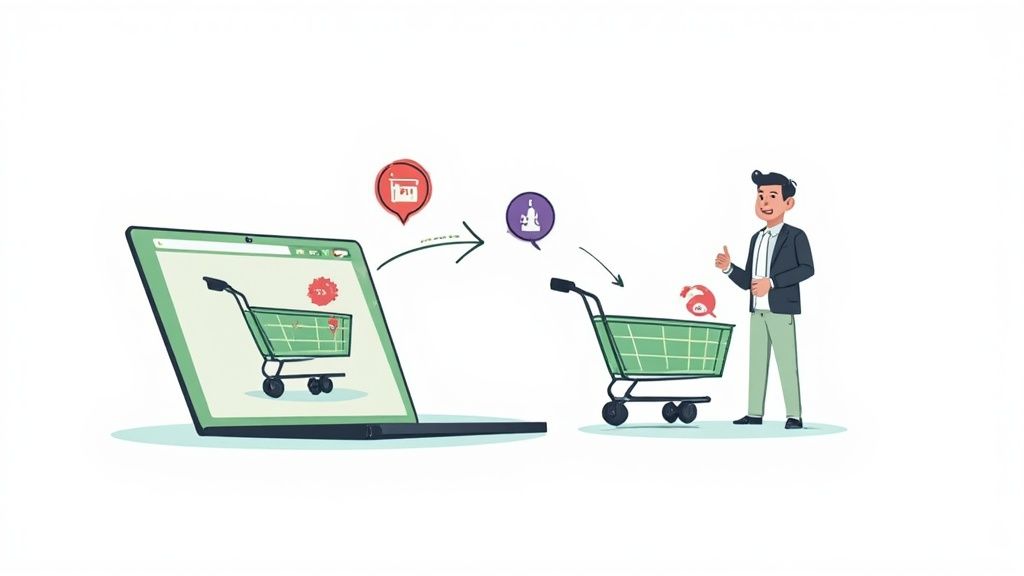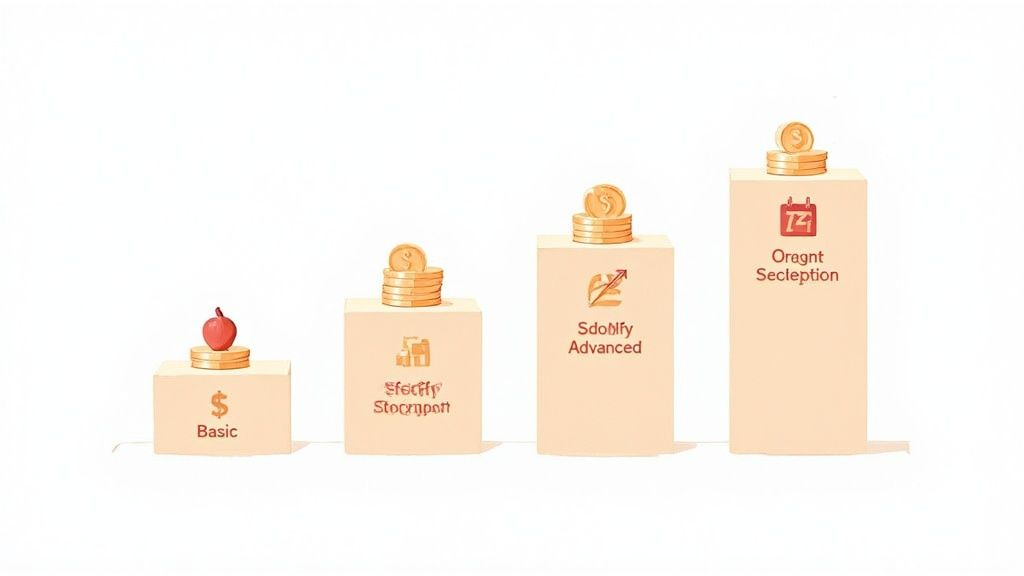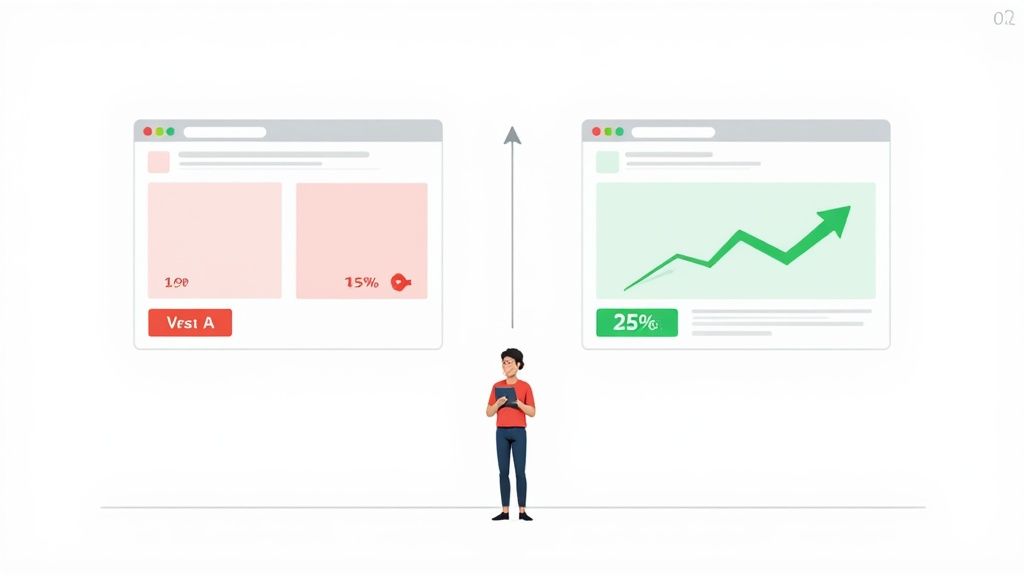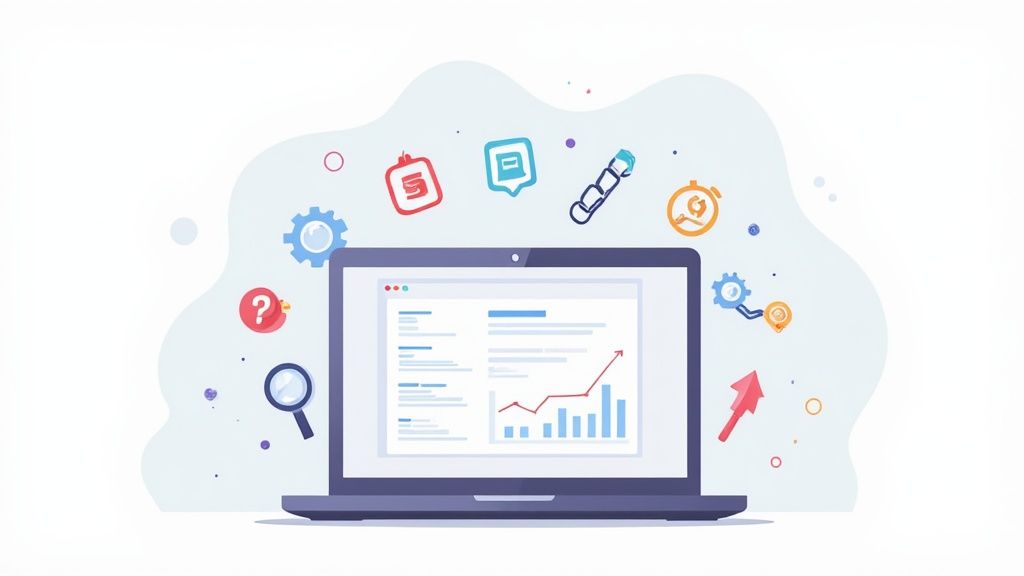
Picking the right ecommerce platform is hands-down the biggest decision you'll make for your online store. It's the engine that powers your ability to scale, market, and just plain operate. If you're a beginner who values simplicity above all else, Shopify is often the best choice. But if you're already on WordPress and crave total control and customization, WooCommerce is unmatched.
This guide cuts through the noise. We're doing a strategic side-by-side comparison to help you choose the right foundation for where your business is heading long-term.
Choosing Your Ecommerce Foundation
Let's be clear: selecting an ecommerce platform isn't just a tech choice. It's a core business decision that will define your brand's future. The platform you commit to dictates everything—from your day-to-day workflow and marketing firepower to your ability to handle growth. Get this wrong, and you’re looking at operational headaches, missed sales, and a painful, expensive migration down the line.
We're going to dig deeper than the typical feature checklists. This comparison is all about the criteria that actually matter when you're in the trenches.
True Cost of Ownership
We'll look beyond the monthly price tag. We’re talking transaction fees, essential app costs, and the potential for developer bills that can sneak up on you.
Scalability and Performance
How does the platform hold up when traffic spikes? Can it manage a massive product catalog without slowing down? We'll see how each one performs under pressure, especially during high-stakes sales events.
Marketing and Optimization Power
This is where the money is made. We'll assess the built-in SEO tools, marketing automation capabilities, and just how powerful each platform's app ecosystem really is.
The Key Platform Contenders
Our focus is on the big three: Shopify, WooCommerce, and BigCommerce. Each one carves out a specific niche, serving everyone from scrappy startups to massive enterprises. Looking at the market data, it’s clearly a two-horse race at the top. Globally, Shopify dominates with 26.2% of all ecommerce sites, powering an incredible 4.65 million stores. WooCommerce isn't far behind, holding a 20.1% market share with over 3.5 million active stores.
Interestingly, when you look at just the highest-traffic websites, Shopify's lead gets even bigger, which speaks volumes about its reputation for scaling. You can explore more about these market dynamics to see how they stack up.
The decision tree below gives you a great visual starting point based on your business size, budget, and how much you want to tinker under the hood.

As you can see, your choice often comes down to a trade-off. Are you looking for out-of-the-box simplicity, or do you need deep, granular control?
The core dilemma in any ecommerce platform comparison is simplicity versus control. Fully hosted platforms offer ease and security, while open-source options provide unlimited flexibility at the cost of increased technical responsibility.
To cut to the chase, I've put together a quick reference guide to help you find your best fit based on your business profile.
Quick Ecommerce Platform Selection Guide
This table summarizes our top picks to help you quickly identify the best platform for your specific situation.
Think of this as your starting point. Now, let's dive into the specifics of what makes each of these platforms tick.
Comparing Daily Operations And Usability
 A platform's real value isn't in the flashy features—it's revealed in the daily grind of running your business. How simple is it to manage orders? How quickly can you update a product? This is what truly impacts your efficiency and, let's be honest, your sanity. This practical ecommerce platform comparison digs into what it actually feels like to operate your store day-to-day on the top three platforms.
A platform's real value isn't in the flashy features—it's revealed in the daily grind of running your business. How simple is it to manage orders? How quickly can you update a product? This is what truly impacts your efficiency and, let's be honest, your sanity. This practical ecommerce platform comparison digs into what it actually feels like to operate your store day-to-day on the top three platforms.
The interface is where you’ll spend countless hours. An intuitive design saves time and prevents mistakes, while a clunky one adds friction to every single task. Let's see how each platform handles the crucial parts of daily operations.
The Dashboard And Initial Setup Experience
Those first few moments with a platform really set the tone. A clear, guided setup gets you selling faster, but a confusing one can kill your momentum before you even start.
Shopify: Famous for its polished onboarding, Shopify gives new users a simple checklist to follow. The main dashboard is clean and logical, putting key metrics like sales, traffic, and best-selling products right in front of you. Adding a new product is a breeze with a single-page form, making it incredibly fast to get your catalog up and running.
WooCommerce: Since it's a plugin, WooCommerce's "dashboard" is built right into the familiar WordPress admin panel. If you're already a WordPress pro, this is a huge advantage. For anyone new to the ecosystem, however, the sheer number of menus for both WordPress and WooCommerce can feel a bit overwhelming. The setup wizard helps, but it’s definitely less hand-held than Shopify.
BigCommerce: BigCommerce finds a nice middle ground between Shopify’s simplicity and the raw power of WooCommerce. Its dashboard is logically organized with a persistent sidebar that makes navigation straightforward. It presents more data and options than Shopify out of the box but is generally easier to get the hang of than the combined WordPress/WooCommerce interface.
Shopify is engineered for speed and simplicity from the ground up. Its entire user experience is designed to minimize the time between having an idea and making your first sale. This makes it the leader for founders who value ease of use over deep, granular control.
Managing Products And Inventory Day-To-Day
Your product catalog is the heart of your store. The ease of adding new items, managing variants like size and color, and tracking stock can vary dramatically between platforms.
Let's look at a common task: creating a single product that comes in five colors and three sizes.
- On Shopify: You create one base product, then add "Color" and "Size" as options. Shopify instantly generates all 15 variants (5 colors x 3 sizes), letting you control the price and inventory for each specific combination from one screen. The process is famously intuitive.
- On WooCommerce: The workflow is similar but involves more clicks. You have to first set the product type to a "Variable product," then define "Attributes" for color and size, and finally generate the "Variations." It's powerful, but it’s a multi-step process that feels less fluid.
- On BigCommerce: This is where the platform really shines. BigCommerce has the most powerful built-in product options of the three, handling complex variations without needing extra apps. Its system is robust enough for stores with thousands of SKUs and complex product rules, which is a major selling point for businesses with intricate catalogs.
Fulfilling Orders And Running Promotions
Once the sales start rolling in, your focus shifts to fulfillment and marketing. How easy it is to process orders and create discounts is a critical part of your daily workload.
Order Management:Shopify and BigCommerce offer very similar, highly efficient order management screens. You can easily view, process, and print shipping labels in bulk. WooCommerce has solid core functionality here, but you'll often need to install an extension for more advanced features like customizing your packing slips.
Creating Discounts:All three platforms handle basic discount codes (like 10% off) with ease. But BigCommerce pulls ahead with its impressive built-in promotion engine. It lets you create complex rules like "Buy one, get one 50% off on a specific category" right out of the box—a feature that usually requires a paid app on Shopify.
Ultimately, the best platform for your daily routine comes down to what you value most. If you want a clean, fast, and almost foolproof interface, Shopify is the clear winner. If you're a WordPress veteran who wants total control, WooCommerce provides a familiar environment. And for businesses with complex product catalogs or the need for sophisticated, built-in promotions, BigCommerce is a compelling and powerful alternative.
Looking Beyond the Sticker Price: What Your Ecommerce Platform Really Costs
When you’re comparing ecommerce platforms, that advertised monthly fee is just the tip of the iceberg. The number you really need to care about is the Total Cost of Ownership (TCO), and it's a far more complicated beast. It’s made up of transaction fees, payment processing charges, critical apps, and maybe even developer time—all of which can sneak up on your budget if you aren't paying attention.
Getting a handle on these hidden expenses is the only way to plan your finances accurately. A platform that looks like a bargain at first can quickly become a money pit as your business grows and your needs get more complex. Let's pull back the curtain on the real costs you'll be facing.
Beyond The Subscription Fee
Your monthly or annual subscription is the most obvious cost, but it's the variable fees that tend to catch merchants by surprise. These are the costs that eat directly into your profit margin on every single sale.
- Transaction Fees: Some platforms will take a small percentage of each sale, on top of what your payment processor charges. Shopify, for instance, applies a transaction fee if you opt to use a third-party payment gateway instead of their built-in Shopify Payments. As you move up to their higher-tier plans, these fees shrink or disappear entirely, giving you a clear incentive to scale.
- Payment Processor Charges: No matter which platform you choose, you'll need a payment gateway like Stripe, PayPal, or Shopify Payments to handle credit card transactions. These services typically charge around 2.9% + $0.30 per transaction. This is a standard, unavoidable cost of doing business online.
One platform that breaks this mold is BigCommerce, which famously charges zero transaction fees across all its plans. This is a huge draw for businesses that want predictable, straightforward costs. Similarly, WooCommerce doesn't have platform-level transaction fees, but you're still on the hook for those standard payment processor charges.
The Hidden Costs of Apps and Plugins
Let's be real: no platform is perfect right out of the box. You're going to need apps, plugins, or extensions to add crucial features like advanced SEO, customer reviews, or subscription models. This is where costs can really start to add up, especially if you're on WooCommerce.
While the core WooCommerce software is free, building a store with all the bells and whistles means buying premium plugins. A good security plugin, an advanced shipping calculator, and a subscription management tool can easily set you back $300-$500 or more per year.
Shopify and BigCommerce both have massive app marketplaces with a mix of free and paid solutions. It's not uncommon for a growing Shopify store to spend $50-$200 per month on essential apps for marketing, loyalty programs, and custom store features.
A "free" platform like WooCommerce can often end up costing just as much—or more—than an all-in-one platform like Shopify. The main difference is where your money is going: to a single, managed provider, or scattered across multiple vendors for hosting, security, and premium plugins.
The Price of Growth and Maintenance
As your business scales, your costs will naturally change. The platform you choose at the beginning will have a massive impact on how these expenses evolve over time.
Here’s a realistic cost snapshot for a business that's hitting its stride.
On paper, this makes the self-hosted route look significantly cheaper for a growing business. But this table doesn't capture the value of enterprise-grade security, performance, and dedicated support that comes bundled with platforms like Shopify. For bigger businesses, the math gets even more complex. To see how these costs scale at the enterprise level, you can find a complete overview in this Shopify Plus pricing guide and calculator that models these expenses in detail.
How Each Platform Handles Business Growth And Scale

Choosing an eCommerce platform isn't just about what works for you today; it’s a bet on where your business will be tomorrow. A crucial piece of any platform comparison is figuring out how well it will hold up when your sales numbers skyrocket. Can it handle the pressure of serious growth, or will it start to buckle?
True scalability goes beyond just handling more traffic. It’s about how the platform supports a massive product catalog, a higher volume of orders, and expansion into totally new markets—all without slowing down or making your team's life harder. Let's dig into how the big players tackle this.
Shopify’s Managed Path To Scale
Shopify’s biggest selling point has always been its managed infrastructure. You simply don't have to think about servers, uptime, or security. As your traffic spikes, Shopify handles all the backend chaos, making sure your store stays snappy and online, even during a high-stakes event like Black Friday.
Growing on Shopify usually means climbing its pricing tiers. Moving up not only cuts your transaction fees but also unlocks more advanced features, additional staff accounts, and better reporting. It lays out a very clear, predictable path for scaling your business.
For brands hitting hyper-growth or those with enterprise-level demands, the final step is the jump to Shopify Plus. This top tier gives you dedicated support, virtually unlimited bandwidth, and powerful APIs for deep, custom integrations. To really get a feel for this leap, check out our guide on the differences between Shopify and Shopify Plus, which breaks down the specific perks for high-volume merchants.
BigCommerce and Built-In Scalability
BigCommerce takes a slightly different approach by building many of its scaling features directly into the core platform, which can cut down on your reliance on third-party apps. It’s especially powerful for businesses managing huge or complex product catalogs, easily handling thousands of SKUs and intricate variations without a hiccup.
Just like Shopify, BigCommerce tiers its plans based on your annual sales volume. As your revenue grows, you’re automatically moved to the next plan. This ensures your store always has the resources it needs to support your sales, though it’s a cost you’ll need to build into your financial planning.
The real game-changer for BigCommerce is its headless commerce capability, often called "BigCommerce as an Engine." This lets ambitious brands separate the backend commerce engine from the frontend customer experience, offering incredible flexibility for crafting truly unique, custom websites.
The Responsibility Of Scaling WooCommerce
With WooCommerce, scalability is a completely different conversation. Since it's a self-hosted platform, the responsibility for performance lands squarely on your shoulders. Your ability to scale is tied directly to the quality of your hosting provider and how well you optimize your site.
A small WooCommerce store might run just fine on basic shared hosting. But as your traffic and orders ramp up, you’ll need to invest in much more powerful solutions like a Virtual Private Server (VPS) or dedicated managed WordPress hosting, which can run into hundreds of dollars a month.
This freedom is both WooCommerce’s greatest strength and its biggest weakness. You have complete control to build a finely tuned, high-performance machine. However, it demands real technical know-how and constant maintenance to ensure your site doesn't crash during a traffic surge. This dynamic makes a direct comparison with SaaS platforms like Shopify tricky; you're essentially comparing a finished product to a powerful toolbox.
The eCommerce market is incredibly competitive. As of 2025, data reveals Amazon dominates with 37.6% of the U.S. online retail market. But the remaining 47.5% is a massive, fragmented space shared by platforms like Shopify, WooCommerce, and BigCommerce. This presents a huge opportunity for brands that choose the right foundation to scale. You can dig deeper into these market share dynamics by reading more on the state of ecommerce.
Evaluating SEO And Built-In Marketing Tools
 A great ecommerce platform does a lot more than just show off your products. It should be a marketing engine, actively helping you find and convert customers. If your platform’s SEO and built-in marketing features are weak, even the most amazing products will go undiscovered. In this part of our ecommerce platform comparison, we're digging past the feature lists to see how each platform’s core setup either helps or hurts your ability to attract new business.
A great ecommerce platform does a lot more than just show off your products. It should be a marketing engine, actively helping you find and convert customers. If your platform’s SEO and built-in marketing features are weak, even the most amazing products will go undiscovered. In this part of our ecommerce platform comparison, we're digging past the feature lists to see how each platform’s core setup either helps or hurts your ability to attract new business.
We'll look at how much real control you get over the technical details that search engines care about—things like clean URL structures, easy meta tag edits, blogging tools, and schema markup for those eye-catching rich results.
Core SEO Capabilities Out Of The Box
Getting SEO right starts with a solid technical foundation. The way a platform handles URLs, site speed, and structured data has a direct impact on whether you show up in search results.
Shopify: Famous for being easy to use, Shopify takes care of a lot of technical SEO for you. It generates sitemaps, adds canonical tags to prevent duplicate content issues, and makes editing titles and meta descriptions incredibly simple. The big drawback? Its URL structure is rigid. You're stuck with /collections/ and /products/ in your URLs, which is a point of frustration for many SEO pros who want full control.
WooCommerce: Since it’s built on WordPress, WooCommerce gives you almost unlimited SEO flexibility. By adding powerhouse plugins like Yoast SEO or Rank Math, you can fine-tune every single aspect of your site’s optimization. This means you can create totally custom URL structures, add advanced schema, and get deep into on-page SEO. That power comes with a trade-off, though: you’re the one responsible for setting it all up and managing it.
BigCommerce: This platform hits a sweet spot. Out of the box, BigCommerce offers more SEO control than Shopify, letting you customize URLs completely without forcing subfolders on you. Its native blogging engine is also a step up from Shopify's, and it manages most technical SEO tasks without making you pay for extra apps.
The key difference in SEO is control versus convenience. Shopify automates much of the process for ease of use, while WooCommerce provides total control for those with the technical skill to use it. BigCommerce offers a strong middle ground, providing more native control than Shopify without the full DIY requirement of WooCommerce.
Built-In Marketing And Sales Tools
Beyond just getting found on Google, your platform needs tools to close sales and bring back lost revenue. Features like abandoned cart recovery, discount codes, and email marketing are non-negotiable for growth.
Let's look at one critical feature—abandoned cart recovery:
- Shopify: Includes a powerful abandoned cart recovery sequence on all its paid plans. You can customize the email templates and decide when the follow-ups go out, a proven tool for winning back lost sales.
- BigCommerce: Just like Shopify, this is a native feature on all plans. The functionality is very similar, giving you an essential tool without needing to install a separate app.
- WooCommerce: This is where the open-source model shows its downside. Abandoned cart recovery isn't included in the free core plugin. You have to buy a paid extension to get it, which is a common pattern—what's standard on SaaS platforms often costs extra with WooCommerce.
Investing in marketing and visibility is what separates the winners from the losers in ecommerce. For perspective, data projected for 2025 shows an enormous gap in ad spending, with Amazon planning to invest an incredible $1.7 billion. That's more than four times what Walmart is spending and is a key reason for Amazon's 37.6% market share. You won't be spending billions, but it shows how vital it is to pick a platform with tools that make your own marketing budget work harder. You can see the full breakdown and learn more about ecommerce advertising trends.
The App Ecosystem For Marketing
No platform does it all, which makes the quality and cost of its app store incredibly important. This is where you'll turn for specialized tools for email marketing, loyalty programs, or advanced analytics.
Both Shopify and BigCommerce have massive app stores with thousands of third-party integrations. Shopify's marketplace is the biggest, but that also means the quality can vary quite a bit. BigCommerce often has fewer choices, but the apps tend to be more deeply integrated. WooCommerce, drawing from the huge WordPress plugin library, offers endless options but demands that you do your homework to make sure everything works together without slowing down your site.
Picking your store's foundation is a big deal. This isn't just about software; it's a commitment. In this final part of our guide, we're moving past feature lists to give you clear, practical advice based on your actual business goals. The truth is, there's no single "best" platform—only the one that’s best for you.
The right choice has to line up with your budget, your team's technical skills, and where you see your business in a few years. Get this right, and your platform will feel like a partner in your growth. Get it wrong, and it can become a major roadblock.
Recommendations For Your Business Type
To cut through the noise, we've matched some common business types with the platform where they'll most likely thrive. Think of this as a compass pointing you in the right direction based on real-world needs.
For Direct-to-Consumer (DTC) Brands Who Need Speed and ReliabilityThere's a reason Shopify is the go-to for modern DTC brands. It’s an all-in-one system with world-class uptime and an interface that just makes sense. It lets you focus on what really matters—your products and your marketing—instead of getting bogged down in technical maintenance. If speed to market is your priority, Shopify is the clear frontrunner.
For Businesses with B2B Needs or Complex CatalogsBigCommerce really starts to shine when things get complicated. It has far more powerful features for B2B, wholesale, and stores with massive, intricate product lists built right in. If you need robust options out of the box without having to bolt on a dozen third-party apps for core functions, BigCommerce is the stronger choice.
For WordPress Veterans and Founders Who Want Total ControlIf your business already lives on WordPress, or if you're the type of founder who wants to control every single pixel and line of code, WooCommerce is the undisputed king. It definitely requires more hands-on technical management, but its flexibility is second to none. You have the power to build a completely custom experience, as long as you have the technical chops to back it up.
Your final decision shouldn't come down to a feature-for-feature spreadsheet. It’s a strategic choice. Are you prioritizing ease of use, built-in power, or total creative freedom? Each platform is a master of one of these domains.
Platform Recommendation Matrix
To wrap things up, here’s a simple matrix to help you visualize our recommendations. It’s a quick way to cross-reference your main business priority with the platform best suited to handle it.
Use this as a final gut check to make your decision with confidence.
Ultimately, this table reinforces the core idea: Shopify is for simplicity and speed, WooCommerce is for ultimate control on WordPress, and BigCommerce is for handling complexity right out of the box.
Frequently Asked Questions About Ecommerce Platforms
When you're down to the wire on picking an ecommerce platform, a few last-minute questions always seem to pop up. Getting these right is the key to making a choice you’ll be happy with for years to come. Let's tackle some of the most common things merchants ask before they sign on the dotted line.
How Hard Is It To Switch Platforms Later?
Let’s be honest: migrating your ecommerce store to a new platform is a serious project, but it’s something countless businesses do every year. The real challenge—and cost—comes down to the size of your store and which platforms you're moving between. Think products, customer accounts, and order history.
For instance, growing out of a platform like Wix or Squarespace and moving to a powerhouse like Shopify is a well-trodden path. There are plenty of services and apps built just to handle that kind of data transfer. The real catch? Custom designs, unique features, and all those app integrations you rely on won't just copy and paste over.
Think of a platform migration like moving to a new house. You can hire movers for the boxes (your product and customer data), but you'll still have to redecorate and set up the utilities (your theme and apps) from scratch. You absolutely have to budget for both the technical migration and the redesign work.
Why Is The App Ecosystem So Important?
A platform's built-in features are just the table stakes. The real magic, and what separates the good from the great, is the app ecosystem. This is what lets you add sophisticated functionality—loyalty programs, advanced analytics, niche marketing tools, subscription models—without hiring a developer for a custom build.
If a platform has a tiny or low-quality app store, you're backed into a corner. You either learn to live without critical features, or you start writing massive checks to developers for custom work. A bustling app marketplace, like those on Shopify or BigCommerce, gives you thousands of battle-tested, affordable solutions at your fingertips. It’s one of the biggest factors in keeping your store nimble and ahead of the competition.
How Do I Future-Proof My Ecommerce Business?
Future-proofing isn’t about gazing into a crystal ball. It’s about picking a platform built for adaptation and growth. Your best bet is to go with a solution that's obsessed with scalability and has a proven history of staying ahead of the curve.
Here’s what to look for:
- Headless Commerce Capabilities: Can the platform's back-end (the commerce engine) be separated from the front-end (the customer-facing site)? This API-driven approach gives you total freedom to create new customer experiences on any device or channel down the road.
- Regular Feature Updates: A platform that's constantly shipping new features and improving what they've already got is investing in its own future—and by extension, yours.
- A Strong Developer Community: When you see a large, active community of developers creating apps and integrations, it's a powerful signal of a healthy, growing platform that others are betting on.
Choosing a platform that checks these boxes means your business can evolve as technology does. It protects your initial investment and sets you up for success, no matter what comes next.
Ready to build an ecommerce store that not only looks great but is also optimized for growth? The team at ECORN specializes in Shopify development and conversion rate optimization to help brands scale effectively. Whether you need a full site build or targeted improvements, our experts are here to help. Explore our flexible packages and see how we can elevate your project.









